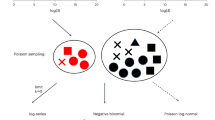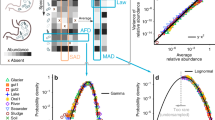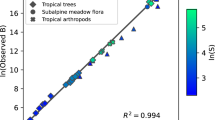Abstract
INTEREST in the pattern of species abundances in a population takes two forms. On the one hand a study of the full distribution of the relative abundances of species may be sought to give insight into the internal mechanisms of the community; in other cases one or more summary statistics which suitably characterise the population may be required to investigate effects of evolutionary or environmental change. The first approach has led to much argument over the appropriate mathematical form for the distribution of abundances, often in the belief that the acceptance of a particular mathematical model will tell us something about the causal biological mechanism. In our opinion, however, the primary purpose of fitting a mathematical model is to smooth the data and enable efficient estimation of population statistics from the parameters of the model; for this we would choose the simplest model which adequately describes the data. Further, there are clear advantages in fitting a single model to describe a series of sets of data—even if this model does not give the best fit to each one—rather than fitting several different models, as has often been suggested, particularly in the literature on succession.
This is a preview of subscription content, access via your institution
Access options
Subscribe to this journal
Receive 51 print issues and online access
$199.00 per year
only $3.90 per issue
Buy this article
- Purchase on Springer Link
- Instant access to full article PDF
Prices may be subject to local taxes which are calculated during checkout
Similar content being viewed by others
References
Taylor, L. R., Kempton, R. A., and Woiwod, I. P., J. anim. Ecol, 45, 255–271 (1976).
Whittaker, R. H., Taxon, 21, 213–251 (1972).
Fisher, R. A., Corbet, A. S., and Williams, C. B., J. anim. Ecol., 12, 42–58 (1943).
Patrick, R., Am. Nat., 102, 173–183 (1968).
Kempton, R. A., and Taylor, L. R., J. anim. Ecol, 43, 381–399 (1974).
Bazzaz, F. A., Ecology, 56, 485–488 (1975).
May, R. M., Nature, 258, 285–286 (1975).
Author information
Authors and Affiliations
Rights and permissions
About this article
Cite this article
KEMPTON, R., TAYLOR, L. Models and statistics for species diversity. Nature 262, 818–820 (1976). https://doi.org/10.1038/262818a0
Received:
Accepted:
Published:
Issue Date:
DOI: https://doi.org/10.1038/262818a0
This article is cited by
-
Application of N2-fixing Paenibacillus triticisoli BJ-18 changes the compositions and functions of the bacterial, diazotrophic, and fungal microbiomes in the rhizosphere and root/shoot endosphere of wheat under field conditions
Biology and Fertility of Soils (2021)
-
Simulation of oyster ecological carrying capacity in Sanggou Bay in the ecosystem context
Aquaculture International (2020)
-
Future scenarios of marine resources and ecosystem conditions in the Eastern Mediterranean under the impacts of fishing, alien species and sea warming
Scientific Reports (2018)
-
Historical changes of the Mediterranean Sea ecosystem: modelling the role and impact of primary productivity and fisheries changes over time
Scientific Reports (2017)
-
Evaluation of PacBio sequencing for full-length bacterial 16S rRNA gene classification
BMC Microbiology (2016)
Comments
By submitting a comment you agree to abide by our Terms and Community Guidelines. If you find something abusive or that does not comply with our terms or guidelines please flag it as inappropriate.



